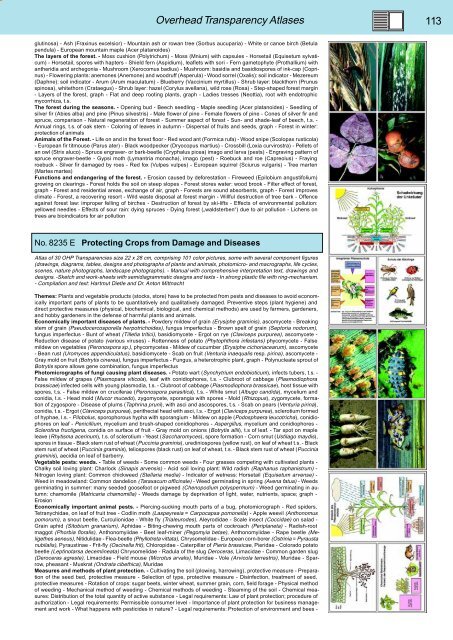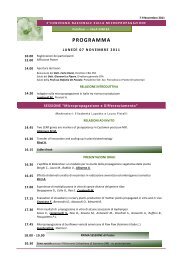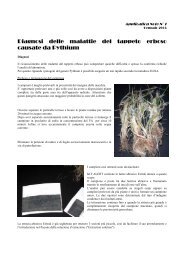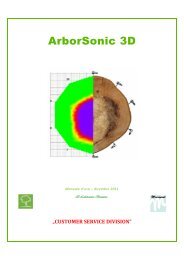BIOLOGY - microscopia.info
BIOLOGY - microscopia.info
BIOLOGY - microscopia.info
Create successful ePaper yourself
Turn your PDF publications into a flip-book with our unique Google optimized e-Paper software.
Overhead Transparency Atlases<br />
113<br />
glutinosa) - Ash (Fraxinus excelsior) - Mountain ash or rowan tree (Sorbus aucuparia) - White or canoe birch (Betula<br />
pendula) - European mountain maple (Acer platanoides)<br />
The layers of the forest. - Moss cushion (Polytrichum) - Moss (Mnium) with capsules - Horsetail (Equisetum sylvaticum)<br />
- Horsetail, spores with hapters - Shield fern (Aspidium), leaflets with sori - Fern gametophyte (Prothallium) with<br />
antheridia and archegonia - Mushroom (Xerocomus badius) - Mushroom: basidia and basidiospores of ink-cap (Coprinus)<br />
- Flowering plants: anemones (Anemone) and woodruff (Asperula) - Wood sorrel (Oxalis): soil indicator - Mezereum<br />
(Daphne): soil indicator - Arum (Arum maculatum) - Blueberry (Vaccinium myrtillus) - Shrub layer: blackthorn (Prunus<br />
spinosa), whitethorn (Crataegus) - Shrub layer: hazel (Corylus avellana), wild rose (Rosa) - Step-shaped forest margin<br />
- Layers of the forest, graph - Flat and deep rooting plants, graph - Ladies tresses (Neottia), root with endotrophic<br />
mycorrhiza, t.s.<br />
The forest during the seasons. - Opening bud - Beech seedling - Maple seedling (Acer platanoides) - Seedling of<br />
silver fir (Abies alba) and pine (Pinus silvestris) - Male flower of pine - Female flowers of pine - Cones of silver fir and<br />
spruce, comparison - Natural regeneration of forest - Summer aspect of forest - Sun- and shade-leaf of beech, t.s. -<br />
Annual rings, t.s. of oak stem - Coloring of leaves in autumn - Dispersal of fruits and seeds, graph - Forest in winter:<br />
protection of animals<br />
Animals of the Forest. - Life on and in the forest floor - Red wood ant (Formica rufa) - Wood snipe (Scolopax rusticola)<br />
- European fir titmouse (Parus ater) - Black woodpecker (Dryocopus martius) - Crossbill (Loxia curvirostra) - Pellets of<br />
an owl (Strix aluco) - Spruce engraver- or bark-beetle (Cryphalus picea) imago and larva (pests) - Engraving pattern of<br />
spruce engraver-beetle - Gypsi moth (Lymantria monacha), imago (pest) - Roebuck and roe (Capreolus) - Fraying<br />
roebuck - Silver fir damaged by roes - Red fox (Vulpes vulpes) - European squirrel (Sciurus vulgaris) - Tree marten<br />
(Martes martes)<br />
Functions and endangering of the forest. - Erosion caused by deforestation - Fireweed (Epilobium angustifolium)<br />
growing on clearings - Forest holds the soil on steep slopes - Forest stores water: wood brook - Filter effect of forest,<br />
graph - Forest and residential areas, exchange of air, graph - Forests are sound absorbents, graph - Forest improves<br />
climate - Forest, a recovering resort - Wild waste disposal at forest margin - Willful destruction of tree bark - Offence<br />
against forest law: improper felling of birches - Destruction of forest by ski-lifts - Effects of environmental pollution:<br />
yellowed needles - Effects of sour rain: dying spruces - Dying forest („waldsterben“) due to air pollution - Lichens on<br />
trees are bioindicators for air pollution<br />
No. 8235 E Protecting Crops from Damage and Diseases<br />
Atlas of 30 OHP Transparencies size 22 x 28 cm, comprising 101 color pictures, some with several component figures<br />
(drawings, diagrams, tables, designs and photographs of plants and animals, photomicro- and macrographs, life cycles,<br />
scenes, nature photographs, landscape photographs). - Manual with comprehensive interpretation text, drawings and<br />
designs. -Sketch and work-sheets with semidiagrammatic designs and texts - In strong plastic file with ring-mechanism.<br />
- Compilation and text: Hartmut Dietle and Dr. Anton Mittnacht<br />
Themes: Plants and vegetable products (stocks, store) have to be protected from pests and diseases to avoid economically<br />
important parts of plants to be quantitatively and qualitatively damaged. Preventive steps (plant hygiene) and<br />
direct protective measures (physical, biochemical, biological, and chemical methods) are used by farmers, gardeners,<br />
and hobby gardeners in the defense of harmful plants and animals.<br />
Economically important diseases of plants. - Powdery mildew of grain (Erysiphe graminis), ascomycete - Breaking<br />
stem of grain (Pseudocercosporella herpotrichoides), fungus imperfectus - Brown spelt of grain (Septoria nodorum),<br />
fungus imperfectus - Bunt of wheat (Tilletia tritici), basidiomycete - Ergot on rye (Claviceps purpurea), ascomycete -<br />
Reduction disease of potato (various viruses) - Rottenness of potato (Phytophthora infestans) phycomycete - False<br />
mildew on vegetables (Peronospora sp.), phycomycetes - Mildew of cucumber (Erysiphe cichoriacearum), ascomycete<br />
- Bean rust (Uromyces appendiculatus), basidiomycete - Scab on fruit (Venturia inaequalis resp. pirina), ascomycete -<br />
Gray mold on fruit (Botrytis cinerea), fungus imperfectus - Fungus, a heterotrophic plant, graph - Polynucleate sprout of<br />
Botrytis spore allows gene combination, fungus imperfectus<br />
Photomicrographs of fungi causing plant diseases. - Potato wart (Synchytrium endobioticum), infects tubers, t.s. -<br />
False mildew of grapes (Plasmopara viticola), leaf with conidiophores, t.s. - Clubroot of cabbage (Plasmodiophora<br />
brassicae) infected cells with young plasmodia, t.s. - Clubroot of cabbage (Plasmodiophora brassicae), host tissue with<br />
spores, t.s. - False mildew on cruciferae (Peronospora parasitica), t.s. - White smut (Albugo candida), mycelium and<br />
conidia, t.s. - Head mold (Mucor mucedo), zygomycete, sporangia with spores - Mold (Rhizopus), zygomycete, formation<br />
of zygospore - Disease of plums (Taphrina pruni), with asci and ascospores, t.s. - Scab on pears (Venturia pirina),<br />
conidia, t.s. - Ergot (Claviceps purpurea), perithecial head with asci, l.s. - Ergot (Claviceps purpurea), sclerotium formed<br />
of hyphae, l.s. - Pilobolus, sporophorous hypha with sporangium - Mildew on apple (Podosphaera leucotricha), conidiophores<br />
on leaf - Penicillium, mycelium and brush-shaped conidiophores - Aspergillus, mycelium and conidiophores -<br />
Sclerotina fructigena, conidia on surface of fruit - Gray mold on onions (Botrytis allii), t.s of leaf. - Tar spot on maple<br />
leave (Rhytisma acerinum), t.s. of sclerotium - Yeast (Saccharomyces), spore formation - Corn smut (Ustilago maydis),<br />
spores in tissue - Black stem rust of wheat (Puccinia graminis), urediniospores (yellow rust), on leaf of wheat t.s. - Black<br />
stem rust of wheat (Puccinia graminis), teliospores (black rust) on leaf of wheat, t.s. - Black stem rust of wheat (Puccinia<br />
graminis), aecidia on leaf of barberry.<br />
Vegetable pests: weeds. - Table of weeds - Some common weeds - Four grasses competing with cultivated plants -<br />
Chalky soil loving plant: Charlock (Sinapis arvensis) - Acid soil loving plant: Wild radish (Raphanus raphanistrum) -<br />
Nitrogen loving plant: Common chickweed (Stellaria media) - Indicator of wetness: Horsetail (Equisetum arvense) -<br />
Weed in meadowland: Common dandelion (Taraxacum officinale) - Weed germinating in spring (Avena fatua) - Weeds<br />
germinating in summer: many seeded goosefoot or pigweed (Chenopodium polyspermum) - Weed germinating in autumn:<br />
chamomile (Matricaria chamomilla) - Weeds damage by deprivation of light, water, nutrients, space; graph -<br />
Erosion<br />
Economically important animal pests. - Piercing-sucking mouth parts of a bug, photomicrograph - Red spiders,<br />
Tetranychidae, on leaf of fruit tree - Codlin moth (Laspeyresia = Carpocapsa pomonella) - Apple weevil (Anthonomus<br />
pomorum), a snout beetle, Curculionidae - White fly (Trialeurodes), Aleyrodidae - Scale insect (Coccidae) on salad -<br />
Grain aphid (Sitobium granarium), Aphidae - Biting-chewing mouth parts of cockroach (Periplaneta) - Radish-root<br />
maggot (Phorbia floralis), Anthonomyiidae - Beet leaf-miner (Pegomyia betae), Anthonomyiidae - Rape beetle (Meligethes<br />
aeneus), Nitidulidae - Flea-beetle (Phyllotreta vittata), Chrysomelidae - European corn-borer (Ostrinia = Pyrausta<br />
nubilalis), Pyraustinae - Frit-fly (Oscinella frit), Chloropidae - Caterpillar of Pieris brassicae, Pieridae - Colorado potato<br />
beetle (Leptinotarsa decemlineata) Chrysomelidae - Radula of the slug Deroceras, Limacidae - Common garden slug<br />
(Deroceras agreste), Limacidae - Field mouse (Microtus arvalis), Muridae - Vole (Arvicola terrestris), Muridae - Sparrow,<br />
pheasant - Muskrat (Ondrata cibethica), Muridae<br />
Measures and methods of plant protection. - Cultivating the soil (plowing, harrowing), protective measure - Preparation<br />
of the seed bed, protective measure - Selection of type, protective measure - Disinfection, treatment of seed,<br />
protective measures - Rotation of crops: sugar beets, winter wheat, summer grain, corn, field forage - Physical method<br />
of weeding - Mechanical method of weeding - Chemical methods of weeding - Steaming of the soil - Chemical measures:<br />
Distribution of the total quantity of active substance - Legal requirements: Law of plant protection; procedure of<br />
authorization - Legal requirements: Permissible consumer level - Importance of plant protection for business management<br />
and work - What happens with pesticides in nature? - Legal requirements: Protection of environment and bees -







